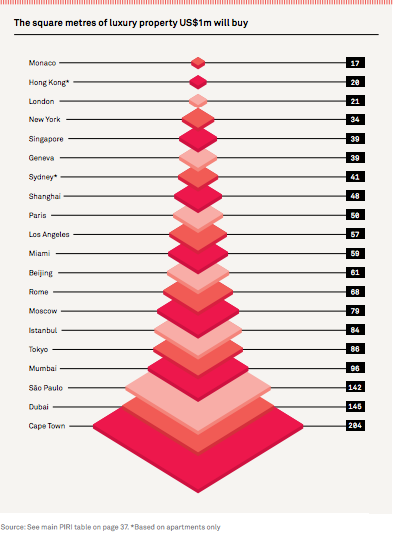 Michael Kors fall/winter 2014 ad campaign
Michael Kors fall/winter 2014 ad campaign
NEW YORK – Last year, 15 people per day joined the ranks of ultra-high-net-worth individuals, a trend that is expected to continue with a predicted 34 percent growth this year, according to The Wealth Report 2015.
The United States launch of the ninth edition of The Wealth Report from Knight Frank and Douglas Elliman was held at One World Trade Center overlooking New York, a fitting location considering the city’s prominence within the findings. The Wealth Report’s glimpse at trends among UHNW individuals focuses on real estate, the top investment among many affluent consumers and a driving force behind economical trends.
“Tell me what the stock market will do and I will tell you what the real estate market is going to do,” said Howard Lorber, chairman at Douglas Elliman, New York.
"The market doesn’t have to be going up, it just can’t go down. If it goes go down, phones stop, traffic stops, but as soon as it picks up again all those people come back,” he said. “If it is down everyday people lose interest… even if they didn’t lose any money they don’t feel like spending money."
Trending among the wealthy
The fifth annual Attitudes Survey from Wealth Report surveys 500 private bankers and wealth advisors from around the world on their UHNW individuals clients’ attitudes. From this survey it has been determined that 80 percent of respondents expect their clients' wealth to grow in the next year.
Also, one-quarter of UHNW individuals are planning to purchase another house this year, a result of 80 percent of these ultra affluents preferring to invest their money directly in property.
Understanding wealth, wealth distribution and how movement of money influences property performance and demand is critical to those looking to understand the ultra affluent, since 23 percent of UHNW individuals’ wealth is held in first and second home portfolio.
 Luxury property locations
In 2014, London was the top city for UHNW individuals, but within 10 years researches predict the number two seat, New York, will surpass London.
UHNW individuals are spread around the globe, but the highest growth concentration is primarily found in Asian cities, despite the 76,000 UHNW individuals who have left China in the past 10 years.
Other countries seeing individuals flee to other places are Russia and India. There have been 114,000 more UHNW individuals added to the United Kingdom in the past 10 years. Also for the future, 33 percent of Russian affluents have reported a plan to move from the country in the future.
Education is a prime factor in many families moving from China, Russia and Indian. The education opportunities in the U.K. and U.S. often outweigh those offered in their home countries.
Also, up-and-coming affluent locations are often noticeable through increased private jet tracts. For instance, New York is one of the largest hubs for private aviation, but cities such as Maiquetia, Venezuela have seen increases in traffic to and from via private planes.
Global effects
New York is continually rising as the top place for affluent consumers, especially with the gradual opening of more properties.
The median price of a three-bedroom apartment in New York has exceeded $3 million, according to real estate firm Town Residential.
For the first quarter of 2015, the New York real estate firm found that shares increased 8.7 percent in the average sale of apartment from $1,683,216 to the current asking price of $1,829,276. Understanding where affluent consumers reside can help luxury brands decide the best neighborhoods to open and maintain a retail presence (see story).
While New York is a main hub for affluents and real estate, the outbound capital flows from Asia will increase 61 percent in 2015 as a result of policy changes in China and Japan that will ease investments, according to Colliers International.
Inbound investment into the region is also predicted to grow this year as supply increases and investors look to expand in Asia. Luxury brands consistently look toward Asian countries for physical and digital expansions, and the increase in space will open opportunities for brands to move more offices and stores into the region and improve relations with affluent Asian clients (see story).
“Different buyers have different reasons,” said David Friedman, president of Wealth-X, New York.
“There are the three S's, for the Russians it's security, for the Chinese it is status and the Middle Eastern buyer is trying to avoid sanctions, they want to go shopping in Paris and all of a sudden there is a sanction and they can’t get through,” he said. “These individuals are the ones buying houses everywhere.”
Final Take
Nancy Buckley, editorial assistant on Luxury Daily, New York
Luxury property locations
In 2014, London was the top city for UHNW individuals, but within 10 years researches predict the number two seat, New York, will surpass London.
UHNW individuals are spread around the globe, but the highest growth concentration is primarily found in Asian cities, despite the 76,000 UHNW individuals who have left China in the past 10 years.
Other countries seeing individuals flee to other places are Russia and India. There have been 114,000 more UHNW individuals added to the United Kingdom in the past 10 years. Also for the future, 33 percent of Russian affluents have reported a plan to move from the country in the future.
Education is a prime factor in many families moving from China, Russia and Indian. The education opportunities in the U.K. and U.S. often outweigh those offered in their home countries.
Also, up-and-coming affluent locations are often noticeable through increased private jet tracts. For instance, New York is one of the largest hubs for private aviation, but cities such as Maiquetia, Venezuela have seen increases in traffic to and from via private planes.
Global effects
New York is continually rising as the top place for affluent consumers, especially with the gradual opening of more properties.
The median price of a three-bedroom apartment in New York has exceeded $3 million, according to real estate firm Town Residential.
For the first quarter of 2015, the New York real estate firm found that shares increased 8.7 percent in the average sale of apartment from $1,683,216 to the current asking price of $1,829,276. Understanding where affluent consumers reside can help luxury brands decide the best neighborhoods to open and maintain a retail presence (see story).
While New York is a main hub for affluents and real estate, the outbound capital flows from Asia will increase 61 percent in 2015 as a result of policy changes in China and Japan that will ease investments, according to Colliers International.
Inbound investment into the region is also predicted to grow this year as supply increases and investors look to expand in Asia. Luxury brands consistently look toward Asian countries for physical and digital expansions, and the increase in space will open opportunities for brands to move more offices and stores into the region and improve relations with affluent Asian clients (see story).
“Different buyers have different reasons,” said David Friedman, president of Wealth-X, New York.
“There are the three S's, for the Russians it's security, for the Chinese it is status and the Middle Eastern buyer is trying to avoid sanctions, they want to go shopping in Paris and all of a sudden there is a sanction and they can’t get through,” he said. “These individuals are the ones buying houses everywhere.”
Final Take
Nancy Buckley, editorial assistant on Luxury Daily, New York
